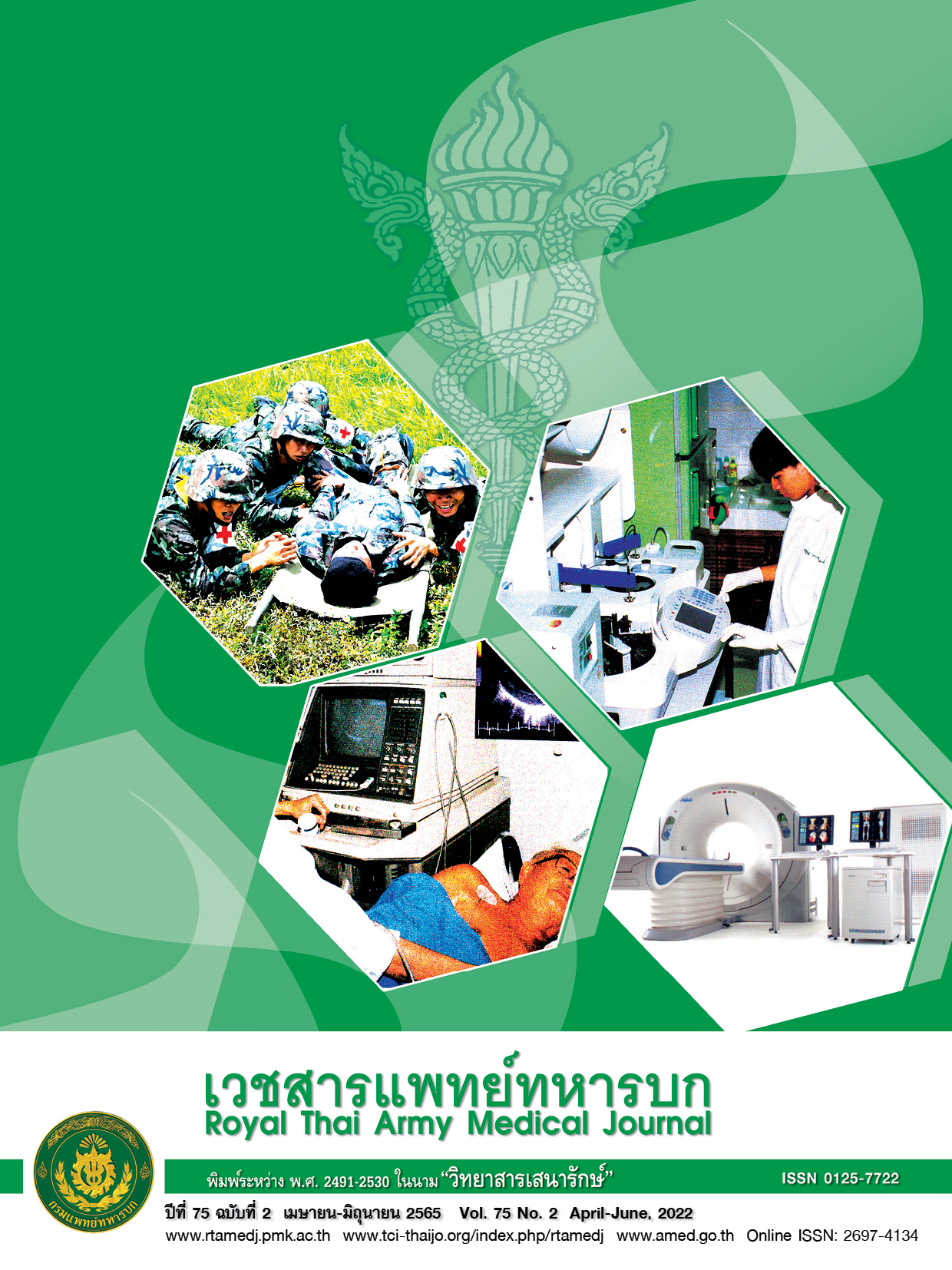การศึกษาการใช้อุปกรณ์การรัดขาด้วยเครื่องใช้แรงดันลม ทดแทน กางเกงรัดขาเพื่อป้องกันภาวะช็อกในทางยุทธวิธีการทหาร ในระหว่างการรักษาผู้ป่วยที่มีภาวะระบบไหลเวียนโลหิตล้มเหลวในหอผู้ป่วยวิกฤตทางอายุรกรรม และศัลยกรรม
Main Article Content
บทคัดย่อ
ความเป็นมา: กางเกงรัดขาเพื่อป้องกันภาวะช็อกในทางทหาร(MAST) ช่วยเพิ่มการไหลเวียนโลหิตโดยเพิ่มค่าความดันเฉลี่ยของระบบไหลเวียนโลหิต (Pms) ทำให้เกิดการเพิ่มการไหลเวียนของระบบเลือดดำกลับเข้าสู่หัวใจ นำไปสู่การเพิ่มความดันโลหิต มีคำแนะนำให้ใช้ในผู้ป่วยช็อกเหตุพิษติดเชื้อที่ไม่สามารถให้ยาต้านการแข็งตัวของเลือดเพื่อป้องกันภาวะลิ่มเลือดอุดตัน ปัจจุบันยังไม่มีการศึกษาผลของ MAST โดยการวัดค่าพารามิเตอร์ที่มีความสัมพันธ์กับการไหลเวียนโลหิตและเปรียบเทียบกับการรักษาตามปกติ
รูปแบบการวิจัย: Randomized, single blind, prospective cohort study
วิธีการศึกษา: ศึกษาในผู้ป่วย 60 รายโดยแบ่ง 2 กลุ่ม โดยกลุ่มที่1 ใช้ MAST และกลุ่มที่ 2 รักษาตามปกติ วัดค่าพารามิเตอร์ที่มีความสัมพันธ์กับการไหลเวียนโลหิตและนำมาเปรียบเทียบโดยใช้หลักการทางสถิติ
ผลการศึกษา: การใช้ MAST ช่วยเพิ่มค่าพารามิเตอร์ที่มีความสัมพันธ์กับการไหลเวียนโลหิตอย่างมีนัยสำคัญได้แก่ ความดันโลหิต (MAP, SBP, DBP), อัตราการไหลเวียนโลหิตออกจากหัวใจ (CO, FTc), ปริมาตรเลือดที่ไหลออกจากหัวใจ(SV, SD) และ ความต้านทานการไหลเวียนโลหิต (SVR) และเมื่อเปรียบเทียบกับการรักษาตามปกติพบว่า MAST มีค่าพารามิเตอร์ที่มีความสัมพันธ์กับการไหลเวียนโลหิตที่มากกว่าอย่างมีนัยสำคัญได้แก่ MAP, SBP, DBP, CO, FTc, SV, SD และ SVR และลดระยะเวลาการนอนในหอผู้ป่วยวิกฤตอย่างมีนัยสำคัญแต่ไม่พบความแตกต่างอย่างมีนัยสำคัญทางสถิติในอัตราการเสียชีวิต
สรุป: ในผู้ป่วยที่มีภาวะระบบไหลเวียนโลหิตล้มเหลว MAST สามารถเพิ่มค่าพารามิเตอร์ที่มีความสัมพันธ์กับการไหลเวียนโลหิตได้มากกว่าการรักษาตามปกติ และ ลดระยะเวลาการนอนในหอผู้ป่วยวิกฤต
Downloads
Article Details

อนุญาตภายใต้เงื่อนไข Creative Commons Attribution-NonCommercial-NoDerivatives 4.0 International License.
บทความในวารสารนี้อยู่ภายใต้ลิขสิทธิ์ของ กรมแพทย์ทหารบก และเผยแพร่ภายใต้สัญญาอนุญาต Creative Commons Attribution-NonCommercial-NoDerivatives 4.0 International (CC BY-NC-ND 4.0)
ท่านสามารถอ่านและใช้งานเพื่อวัตถุประสงค์ทางการศึกษา และทางวิชาการ เช่น การสอน การวิจัย หรือการอ้างอิง โดยต้องให้เครดิตอย่างเหมาะสมแก่ผู้เขียนและวารสาร
ห้ามใช้หรือแก้ไขบทความโดยไม่ได้รับอนุญาต
ข้อความที่ปรากฏในบทความเป็นความคิดเห็นของผู้เขียนเท่านั้น
ผู้เขียนเป็นผู้รับผิดชอบต่อเนื้อหาและความถูกต้องของบทความของตนอย่างเต็มที่
การนำบทความไปเผยแพร่ซ้ำในรูปแบบสาธารณะอื่นใด ต้องได้รับอนุญาตจากวารสาร
เอกสารอ้างอิง
2. Lateef F, Kelvin T. Military anti-shock garment. J Emerg Trauma Shock. 2008;1:63-9.
3. Christopher RL, Evi K, Mustapha A, George G. Pneumatic compression reduces calf volume and augments the VR. Phlebology. 2015;30:316–322.
4. Chen AH, Frangos SG, Kilaru S, Sumpio BE. Pneumatic leg compression devices-physiological mechanisms of action. Eur J Vasc Endovasc Surg.2001;21:383-92.
5. Rhodes A, Evans LE, Alhazzani W, Levy MM, Antonelli M, Ferrer R, et al. Surviving sepsis campaign: International guidelines for management of sepsis and septic shock: 2016. Intensive Care Med. 2017;43: 304-377
6. Zadeh FJ, Alqozat M, Zadeh RA. Sequential compression pump effect on hypotension due to spinal anesthesia for cesarean section: A double blind clinical trial. Electron Physician. 2017; 9(5): 4419–4424.
7. Bernard SA, Smith K, Finn J, Hein C, Grantham H, Bray JE, et al. Induction of therapeutic hypothermia during out-of-hospital cardiac arrest using a rapid infusion of cold saline: the RINSE trial (Rapid Infusion of Cold Normal Saline). Circulation. 2016;134(11):797–805.
8. Kim F, Nichol G, Maynard C, Hallstrom A, Kudenchuk PJ, Rea T, et al. Effect of prehospital induction of mild hypothermia on survival and neurological status among adults with cardiac arrest: a randomized clinical trial. JAMA. 2014;311(1):45.
9. Butler FK, Blackbourne LH. Battlefield Trauma Care then and now: a decade of tactical combat casualty care. J trauma acute care surg. 2012 volume 73, number 6.
10. Griffin M, Kakkos SK, Geroulakos G, Nicolaides AN. Comparison of three intermittent pneumatic compression systems in patients with varicose veins. Int Angiol. 2007; 26(2): 158-64.


